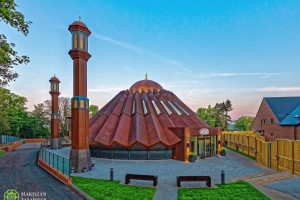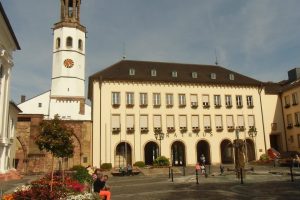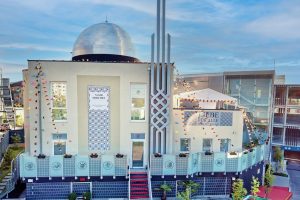Also known as ‘Morden Mosque’, Baitul Futuh, which translates as ‘the House of Victories’, was inaugurated in 2003 at a cost of £15 million. Situated in Morden, South West London, it is one of the largest mosques in Western Europe, and has the capacity to generously accommodate 13,000 worshippers counting the adjacent halls. Some may think that the mosque was externally funded, whereas in fact it was entirely funded by members of the Ahmadiyya Muslim Community. Earlier today the 5th Caliph of the Ahmadiyya Muslim Community, Hazrat Mirza Masroor Ahmad (aba), made a special visit to inspect the new complex, marking a major milestone in this historic redevelopment. This redevelopment isn’t just significant for Ahmadi Muslims, but the local community here are also eagerly anticipating the completion of this project, which is recognised as an iconic building in London.

Not Just a Large Mosque
It’s not just an incredibly large mosque, the complex also includes an administrative block which is the location of MTA International Studios, an international Muslim Television station which broadcasts 24/7 on Sky in the UK, and across eight channels globally. Baitul Futuh even hosts a radio station called ‘Voice Of Islam Radio’ (VOI) which broadcasts 24/7 on DAB radio. It has even been a place where many received their COVID vaccinations as part of the UK’s national vaccination drive and has featured in national media for its homeless feeding and blood donation drives. For its unique architecture and design, it was listed in the ‘Best 50 Modern Religious Buildings’ published by The Independent and it featured in the 2015 TV documentary ‘Britain’s Biggest Mosque’ by Channel 5.
The Baitul Futuh Mosque also hosts its annual National Peace Symposium, attended by secretaries of state, parliamentarians and diplomats. The Baitul Futuh Mosque is clearly an integral pillar of the fabric of the area.
An Unexpected Tragedy
In September 2015, a major fire occurred within the administrative complex. Plumes of smoke were to be seen from miles away; an initial tragedy for the Ahmadiyya Muslim Community. Whilst many friends and neighbours showed their support for the community in their grief, unfortunately, some elements rejoiced in the burning of the building. However the Caliph at the time said during his Friday Sermon, that from the ashes of the burnt building, will rise magnificent new opportunities. Although a major part of the administrative complex was affected, the mosque itself didn’t sustain any damage.
Nevertheless, the Baitul Futuh Mosque is undergoing a major rejuvenation for its reconstruction to build bigger and better administrative blocks with stunning architectural designs a prominent feature.

The Caliph’s First Visit to Baitul Futuh Since the Pandemic
Pre-pandemic, the Caliph would often deliver his weekly Friday Sermons from Baitul Futuh, seen around the world by a global audience through MTA and would often visit to grace other events. However since the pandemic and various lockdowns and restrictions to travel due to Covid, the Caliph has not been able to visit the complex from his residence in Islamabad, Tilford, UK. “We had invited His Holiness to grace us with his presence and inspect the latest phase of progress in the re-development project,” explained Rafiq Hayat, the National President of the Ahmadiyya Muslim Community UK, whom The Review of Religions spoke to after the visit. “When the building burned down, His Holiness mentioned in the Friday Sermon that today these people are rejoicing that their building has burned down and the fact that why didn’t their mosque burn down, but inshallah we will build such a beautiful thing here that we will be saying ‘MashAllah and Alhamdolillah.’”
“I requested His Holiness to honour us because during COVID obviously he couldn’t come. It’s been around a year and a half when we asked His Holiness to come and he very kindly accepted. In between I have been updating him with photos and information and he taken very keen interest. So when I kindly requested him I mentioned this is the time because if there’s any key changes needing to be made, we’re just at that stage…so His Holiness very kindly approved the visit.”

His Holiness toured nearly all parts of the redevelopment area, as Rafiq Hayat detailed: “Outside there is a walkway along the side of the new build, which His Holiness instructed should be extended all the way to the mosque.” His Holiness at the external and asked how far the screens are coming down and asked about the arches and what the walkway is going to be. We went onto the different floors, I explained to His Holiness how it was working. We looked at the secondary staircase that’s been put in because we found out that if we get 1,000 people on the first floor, it would require a secondary fire escape. So we have to create a new fire escape.”
There is currently a walkway along the colonnade, which Rafiq Hayat explained: “His Holiness said that he loved the stones and would like the stone, even it goes along the walkway and we paint above, he would like the stones to follow on all the way to the mosque.”
World Famous Architect
Rafiq Hayat explained that the Community recruited the services of a world famous architect and design company, he said: “Fanos Panayides is a world-famous architect who was responsible for a lot of major buildings in the UK and abroad. He is the one who designed this building and due to our personal connection with him and considering the nature of this project, did so at a much reduced rate than normal.”
Fanos is a director at John McAslan and Partners (JMP). His impressive resume with his company has taken him around the world, and most recently has been leading JMP’s major transport projects in Sydney Australia. Other prominent and often award winning projects have included Belfast Transport Hub, London and Kingston University, Mandarin Oriental, Cultural Forum, and the Msheireb Museums and Jumaa Mosque in Doha, Qatar. The new design of the Baitul Futuh complex administrative hub is truly stunning, and echoes the designs of classical Islamic architecture from Islam’s Golden Age.

What to Expect from the New Build
The Review of Religions spoke to Irfan Qureshi, the National Secretary of Properties for the Ahmadiyya Muslim Community UK, who had the honour of also answering questions His Holiness was asking during the visit.
“It was a huge honour for us to welcome His Holiness to the Baitul Futuh Mosque Construction site” he explained with excitement. “His Holiness felt satisfied with the progress and he further asked some detailed questions.”
Irfan delved into some intriguing aspects of the redevelopment, many of which were conveyed to His Holiness during the visit, he said: “The design of the new building is in harmony with the existing building. It provides a direct link from both sides to the main mosque.” During the visit, His Holiness asked if the barrel vaults would be hung from the ceiling in the colonnade, to which the committee replied in the affirmative. Irfan gave further details: “The new building comprises of two large halls, namely the Nasir Hall on the ground floor and the Noor Hall on the first. His Holiness asked the capacity of the Noor Hall and we replied that it was around 1000 people for prayers.”
Either side of Nasir Hall are two mezzanine floors making space for some office accommodation on the two floor spaces. The first floor is split into two spaces with Noor Hall to the front on one side and offices for the auxiliary associations, conference room on the other side. Irfan explained that “the second floor is fully dedicated to UK Ahmadiyya Muslim Community offices and some meeting or consultation rooms. The third and fourth floors are dedicated to special guests with 12 private twin rooms and 6 dormitories in total. A sample twin room was set up with furniture today for viewing and His Holiness felt satisfied with the type of furniture being installed.”
Rafiq Hayat further explained that His Holiness was shown areas where an exhibition is being developed, the west wing which contains the comms room and also offices, he said: “His Holiness asked us about the offices behind the Noor Hall and how they would be finished and what the plan was. We mentioned there would be glass, as His Holiness enquired how the big gap would be filled. One of the key features is how to bring the light in and this is how the whole thing has been planned, which you can see with the huge height of the colonnade. The walkways are also generous in space. We walked up to the next floor and His Holiness looked out of the MTA gantry with the satellite dishes and so on. Then we showed His Holiness some of the guest rooms, one of which we had done. The rooms are the same size as hotel rooms. There are also some dormitories.”

His Holiness Leads the Prayer in Baitul Futuh After Nearly Two Years – and a Surprise Meeting
His Holiness led the Zuhr and Asr (Afternoon) prayers in the Baitul Futuh. The visit of His Holiness was not publically announced, yet the mosque was full to the brim. “We did not tell anyone in fact I did not even know, but through word of mouth people came in numbers!” explained Naseem Bajwa, Imam of the Baitul Futuh Mosque, who had the honour of His Holiness speaking to after the prayers. Imam Bajwa explained that “one local President of the Ahmadiyya Muslim Community said to me we did not tell anyone yet so many people came! In fact after the prayer His Holiness looked at me and I stood up, and he asked ‘do so many people come for the afternoon prayer daily?’ I said no and he asked me how many normally, to which I said 30-40. His Holiness then asked ‘how many people normally come for Ishaa (night) prayers,’ to which I replied ‘around 70’. I also mentioned that the attendance today was similar to what we see for the Friday Prayer. In short His Holiness was especially happy that people had attended the mosque in large numbers’
The locals were delighted and it was nothing short of an Eid for them to see His Holiness and pray behind him after so long, explained Imam Bajwa. “I am going to mention in my upcoming Friday Sermon here about His Holiness’ visit and that he was especially enquiring about numbers of people who attend, which means we should all make an effort. Many people have a misconception that they should not attend the mosque for prayers. The visit of His Holiness has removed this misconception and shown that people should come. Anyhow, all precautions are taken, people should test themselves before coming, we check people’s temperatures, everyone is required to bring their own prayer mat and mask, and for those who forget we have disposable mats and masks. His Holiness said in in one missionary’s meeting to use an incense type material (dhooni) in all mosques, which is burnt and purifies the air or is a type of disinfectant. So there is nothing to worry about if these precautions are taken and people should be inspired by His Holiness’ personal example and also come to pray here.”
When Will the Redevelopment be Complete?
When can we expect the completion of this remarkable redevelopment project? “I think God Willing we will be able to inaugurate this before Jalsa 2022, in July or August”, mentioned Rafiq Hayat. With Covid still a major factor in how society operates, there yet could be changes to the schedule, however what is clear is that the ‘House of Victories’ is on course for completion for a new phase in its wonderful history. The local community are also eager as this is a key landmark building in their borough, and as such this is an important milestone not just for the Ahmadiyya Muslim Community UK, but also for Morden, London and Community members globally.




Add Comment